Tesco's Operations Management: Service Delivery Process and Success
VerifiedAdded on 2023/04/20
|11
|3299
|128
Report
AI Summary
This report provides an overview of Tesco's operations management, focusing on its business activities and service delivery processes. It details Tesco's various store formats, from superstores to express outlets, and examines the primary activities within its service delivery process, including inbound logistics, operations, outbound logistics, marketing & sales, and support activities such as infrastructure, human resource management, and technological development. The report also identifies key success factors for Tesco, such as branding, IT integration, supplier management, and customer loyalty, while acknowledging recent failures like its limited success in the Chinese market. Recommendations are provided to improve Tesco's home-delivery services and overall operational effectiveness. This analysis aims to provide insights into Tesco's operational strategies and their impact on the company's performance in the retail sector. Desklib offers a range of similar solved assignments and resources for students.
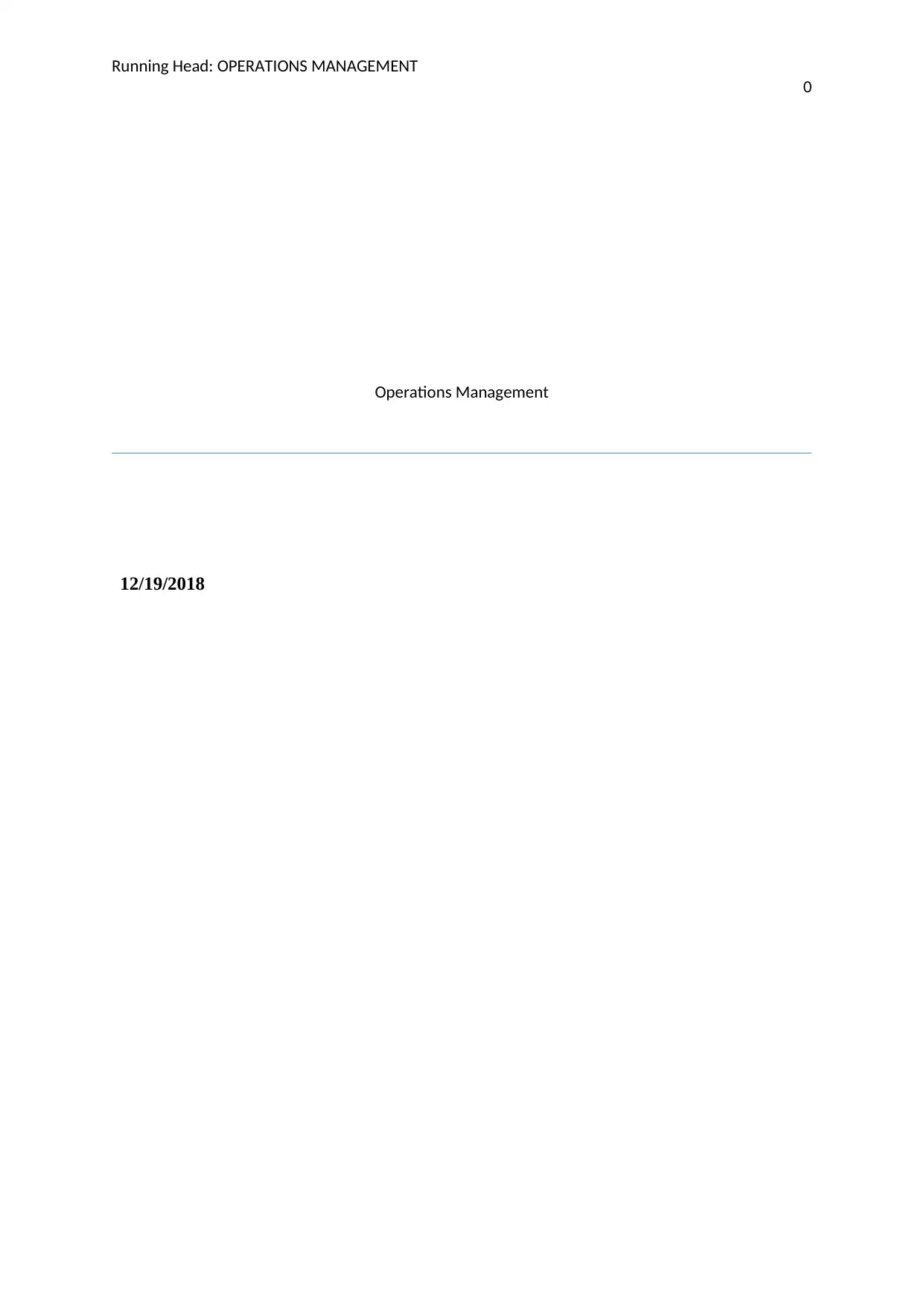
Running Head: OPERATIONS MANAGEMENT
0
Operations Management
12/19/2018
0
Operations Management
12/19/2018
Paraphrase This Document
Need a fresh take? Get an instant paraphrase of this document with our AI Paraphraser
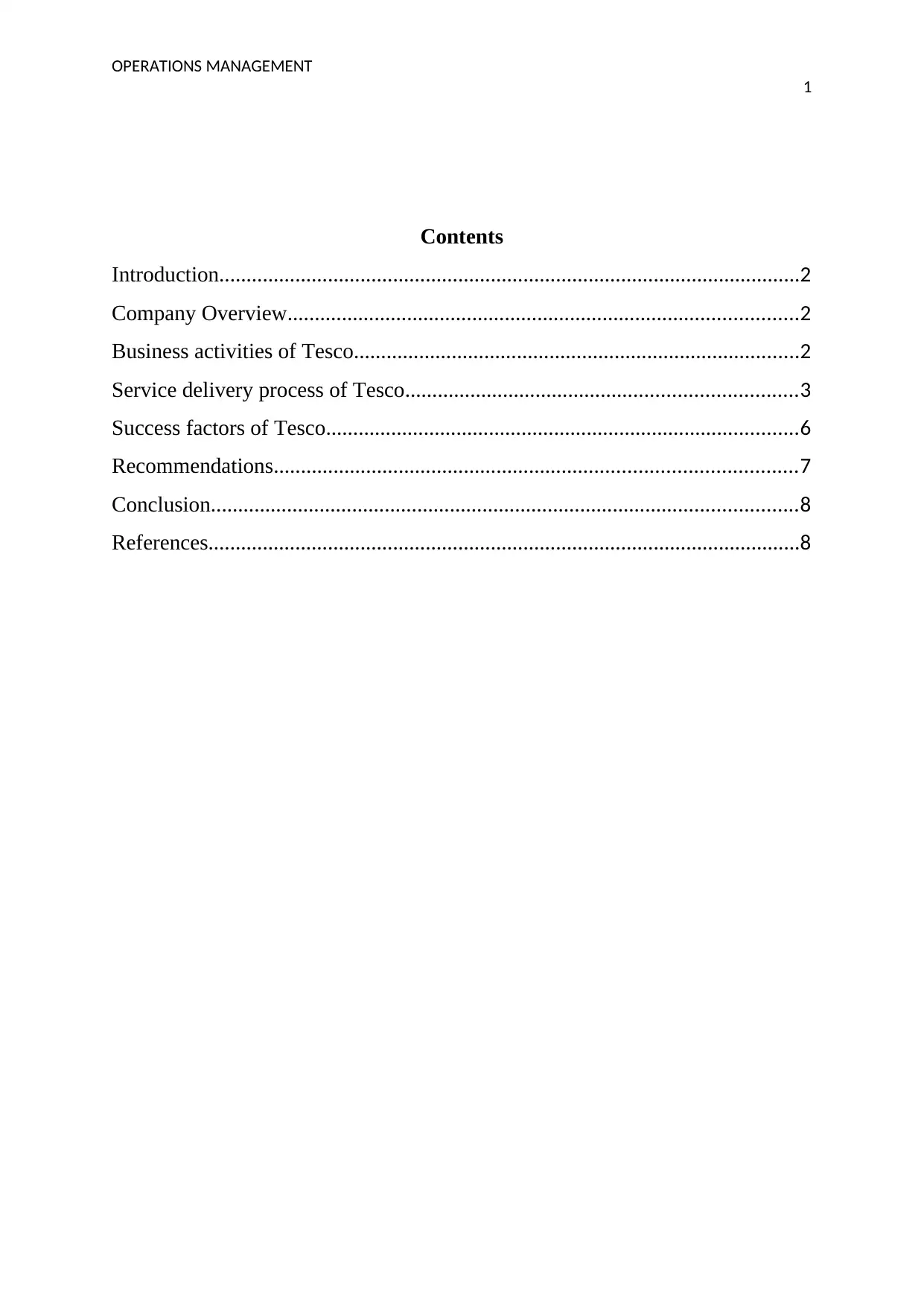
OPERATIONS MANAGEMENT
1
Contents
Introduction...........................................................................................................2
Company Overview..............................................................................................2
Business activities of Tesco..................................................................................2
Service delivery process of Tesco........................................................................3
Success factors of Tesco.......................................................................................6
Recommendations................................................................................................7
Conclusion............................................................................................................8
References.............................................................................................................8
1
Contents
Introduction...........................................................................................................2
Company Overview..............................................................................................2
Business activities of Tesco..................................................................................2
Service delivery process of Tesco........................................................................3
Success factors of Tesco.......................................................................................6
Recommendations................................................................................................7
Conclusion............................................................................................................8
References.............................................................................................................8
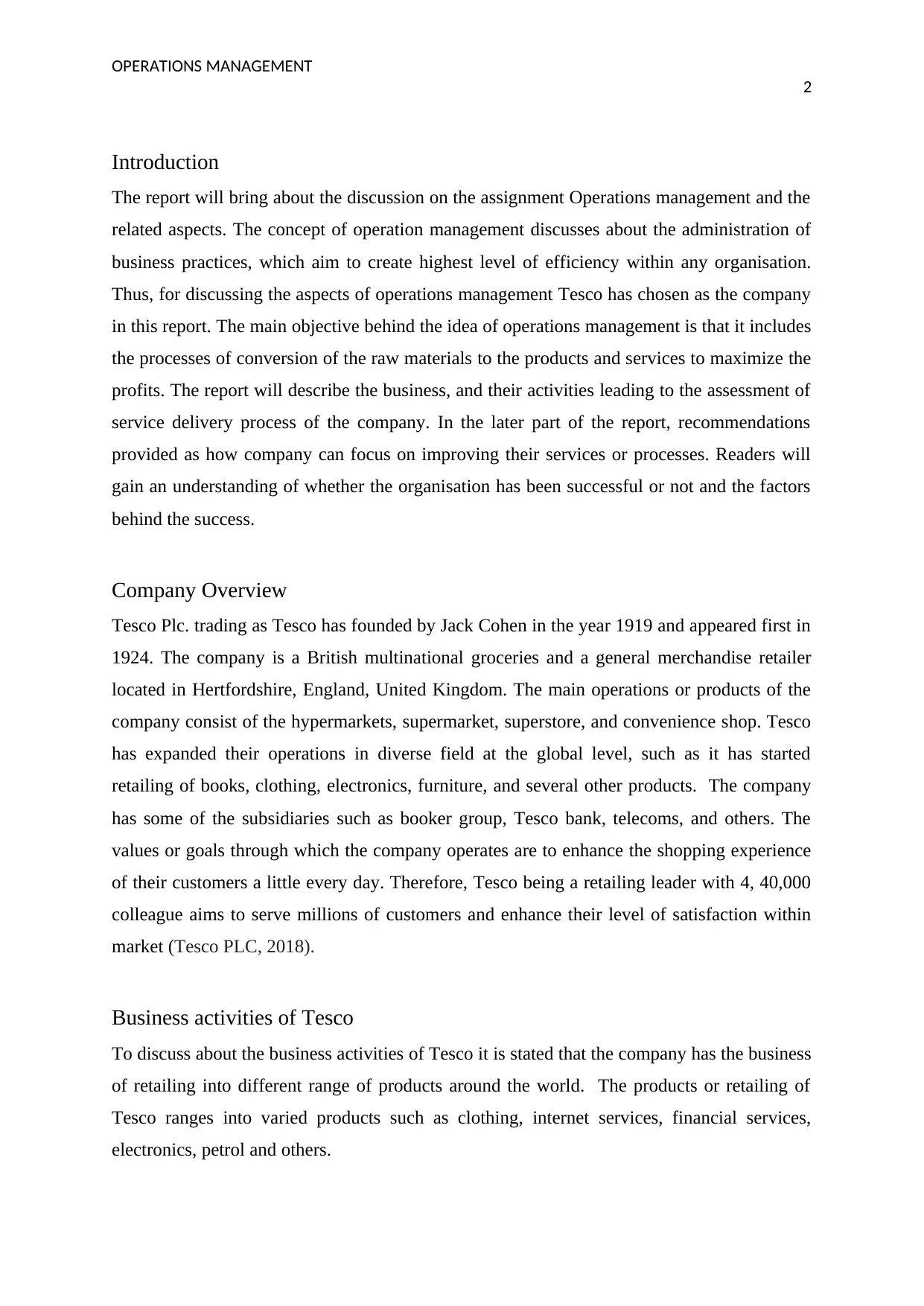
OPERATIONS MANAGEMENT
2
Introduction
The report will bring about the discussion on the assignment Operations management and the
related aspects. The concept of operation management discusses about the administration of
business practices, which aim to create highest level of efficiency within any organisation.
Thus, for discussing the aspects of operations management Tesco has chosen as the company
in this report. The main objective behind the idea of operations management is that it includes
the processes of conversion of the raw materials to the products and services to maximize the
profits. The report will describe the business, and their activities leading to the assessment of
service delivery process of the company. In the later part of the report, recommendations
provided as how company can focus on improving their services or processes. Readers will
gain an understanding of whether the organisation has been successful or not and the factors
behind the success.
Company Overview
Tesco Plc. trading as Tesco has founded by Jack Cohen in the year 1919 and appeared first in
1924. The company is a British multinational groceries and a general merchandise retailer
located in Hertfordshire, England, United Kingdom. The main operations or products of the
company consist of the hypermarkets, supermarket, superstore, and convenience shop. Tesco
has expanded their operations in diverse field at the global level, such as it has started
retailing of books, clothing, electronics, furniture, and several other products. The company
has some of the subsidiaries such as booker group, Tesco bank, telecoms, and others. The
values or goals through which the company operates are to enhance the shopping experience
of their customers a little every day. Therefore, Tesco being a retailing leader with 4, 40,000
colleague aims to serve millions of customers and enhance their level of satisfaction within
market (Tesco PLC, 2018).
Business activities of Tesco
To discuss about the business activities of Tesco it is stated that the company has the business
of retailing into different range of products around the world. The products or retailing of
Tesco ranges into varied products such as clothing, internet services, financial services,
electronics, petrol and others.
2
Introduction
The report will bring about the discussion on the assignment Operations management and the
related aspects. The concept of operation management discusses about the administration of
business practices, which aim to create highest level of efficiency within any organisation.
Thus, for discussing the aspects of operations management Tesco has chosen as the company
in this report. The main objective behind the idea of operations management is that it includes
the processes of conversion of the raw materials to the products and services to maximize the
profits. The report will describe the business, and their activities leading to the assessment of
service delivery process of the company. In the later part of the report, recommendations
provided as how company can focus on improving their services or processes. Readers will
gain an understanding of whether the organisation has been successful or not and the factors
behind the success.
Company Overview
Tesco Plc. trading as Tesco has founded by Jack Cohen in the year 1919 and appeared first in
1924. The company is a British multinational groceries and a general merchandise retailer
located in Hertfordshire, England, United Kingdom. The main operations or products of the
company consist of the hypermarkets, supermarket, superstore, and convenience shop. Tesco
has expanded their operations in diverse field at the global level, such as it has started
retailing of books, clothing, electronics, furniture, and several other products. The company
has some of the subsidiaries such as booker group, Tesco bank, telecoms, and others. The
values or goals through which the company operates are to enhance the shopping experience
of their customers a little every day. Therefore, Tesco being a retailing leader with 4, 40,000
colleague aims to serve millions of customers and enhance their level of satisfaction within
market (Tesco PLC, 2018).
Business activities of Tesco
To discuss about the business activities of Tesco it is stated that the company has the business
of retailing into different range of products around the world. The products or retailing of
Tesco ranges into varied products such as clothing, internet services, financial services,
electronics, petrol and others.
⊘ This is a preview!⊘
Do you want full access?
Subscribe today to unlock all pages.

Trusted by 1+ million students worldwide
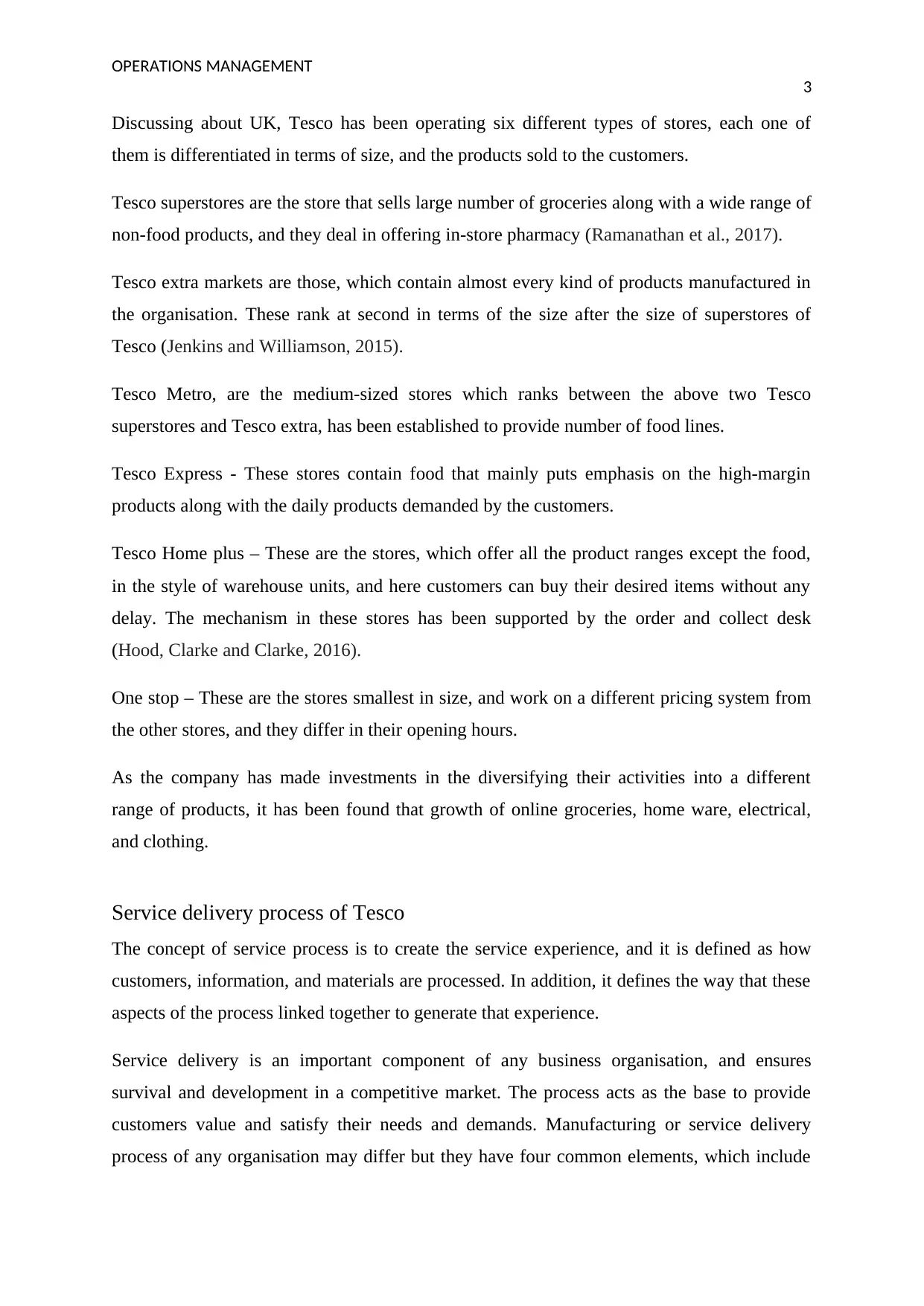
OPERATIONS MANAGEMENT
3
Discussing about UK, Tesco has been operating six different types of stores, each one of
them is differentiated in terms of size, and the products sold to the customers.
Tesco superstores are the store that sells large number of groceries along with a wide range of
non-food products, and they deal in offering in-store pharmacy (Ramanathan et al., 2017).
Tesco extra markets are those, which contain almost every kind of products manufactured in
the organisation. These rank at second in terms of the size after the size of superstores of
Tesco (Jenkins and Williamson, 2015).
Tesco Metro, are the medium-sized stores which ranks between the above two Tesco
superstores and Tesco extra, has been established to provide number of food lines.
Tesco Express - These stores contain food that mainly puts emphasis on the high-margin
products along with the daily products demanded by the customers.
Tesco Home plus – These are the stores, which offer all the product ranges except the food,
in the style of warehouse units, and here customers can buy their desired items without any
delay. The mechanism in these stores has been supported by the order and collect desk
(Hood, Clarke and Clarke, 2016).
One stop – These are the stores smallest in size, and work on a different pricing system from
the other stores, and they differ in their opening hours.
As the company has made investments in the diversifying their activities into a different
range of products, it has been found that growth of online groceries, home ware, electrical,
and clothing.
Service delivery process of Tesco
The concept of service process is to create the service experience, and it is defined as how
customers, information, and materials are processed. In addition, it defines the way that these
aspects of the process linked together to generate that experience.
Service delivery is an important component of any business organisation, and ensures
survival and development in a competitive market. The process acts as the base to provide
customers value and satisfy their needs and demands. Manufacturing or service delivery
process of any organisation may differ but they have four common elements, which include
3
Discussing about UK, Tesco has been operating six different types of stores, each one of
them is differentiated in terms of size, and the products sold to the customers.
Tesco superstores are the store that sells large number of groceries along with a wide range of
non-food products, and they deal in offering in-store pharmacy (Ramanathan et al., 2017).
Tesco extra markets are those, which contain almost every kind of products manufactured in
the organisation. These rank at second in terms of the size after the size of superstores of
Tesco (Jenkins and Williamson, 2015).
Tesco Metro, are the medium-sized stores which ranks between the above two Tesco
superstores and Tesco extra, has been established to provide number of food lines.
Tesco Express - These stores contain food that mainly puts emphasis on the high-margin
products along with the daily products demanded by the customers.
Tesco Home plus – These are the stores, which offer all the product ranges except the food,
in the style of warehouse units, and here customers can buy their desired items without any
delay. The mechanism in these stores has been supported by the order and collect desk
(Hood, Clarke and Clarke, 2016).
One stop – These are the stores smallest in size, and work on a different pricing system from
the other stores, and they differ in their opening hours.
As the company has made investments in the diversifying their activities into a different
range of products, it has been found that growth of online groceries, home ware, electrical,
and clothing.
Service delivery process of Tesco
The concept of service process is to create the service experience, and it is defined as how
customers, information, and materials are processed. In addition, it defines the way that these
aspects of the process linked together to generate that experience.
Service delivery is an important component of any business organisation, and ensures
survival and development in a competitive market. The process acts as the base to provide
customers value and satisfy their needs and demands. Manufacturing or service delivery
process of any organisation may differ but they have four common elements, which include
Paraphrase This Document
Need a fresh take? Get an instant paraphrase of this document with our AI Paraphraser
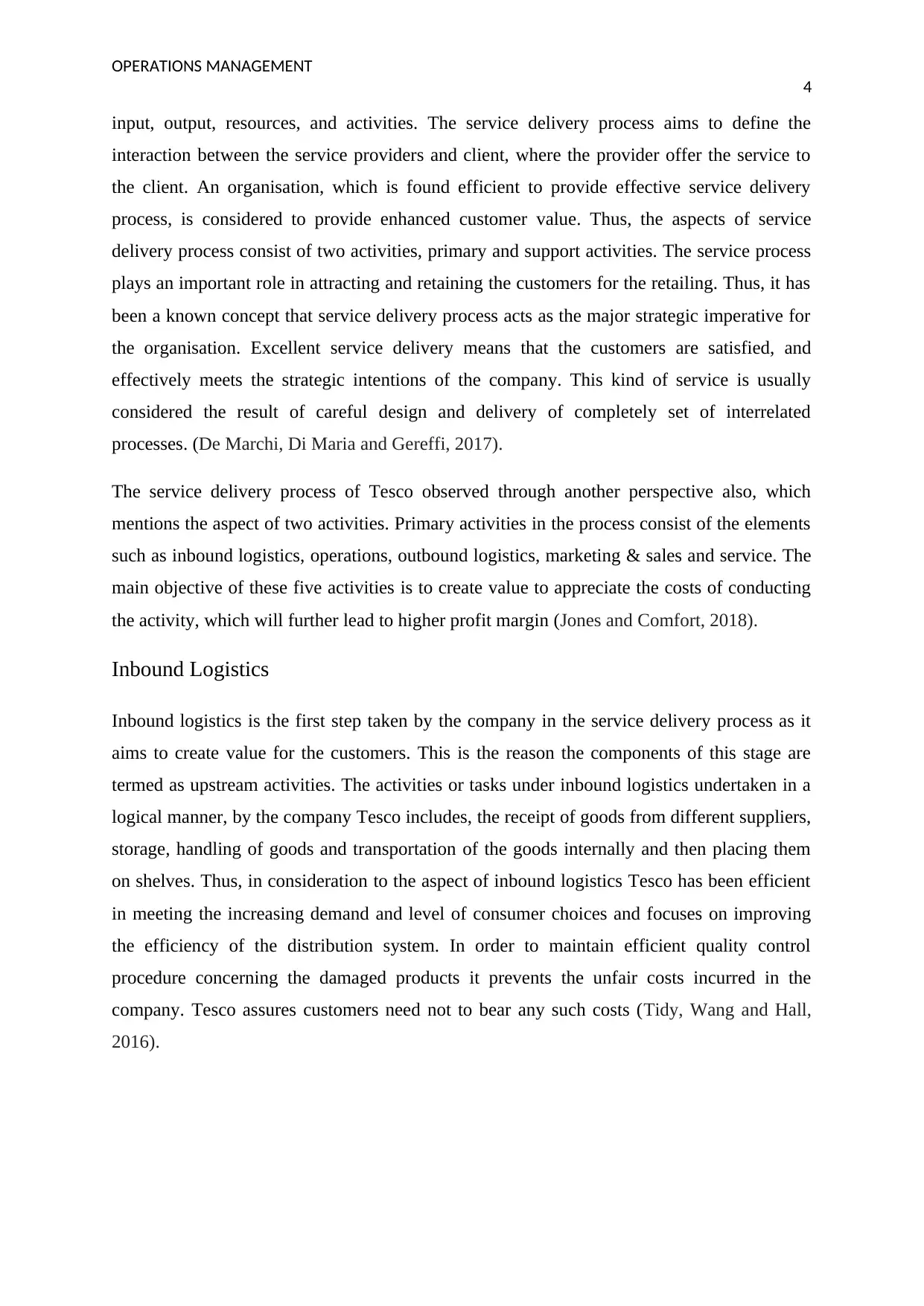
OPERATIONS MANAGEMENT
4
input, output, resources, and activities. The service delivery process aims to define the
interaction between the service providers and client, where the provider offer the service to
the client. An organisation, which is found efficient to provide effective service delivery
process, is considered to provide enhanced customer value. Thus, the aspects of service
delivery process consist of two activities, primary and support activities. The service process
plays an important role in attracting and retaining the customers for the retailing. Thus, it has
been a known concept that service delivery process acts as the major strategic imperative for
the organisation. Excellent service delivery means that the customers are satisfied, and
effectively meets the strategic intentions of the company. This kind of service is usually
considered the result of careful design and delivery of completely set of interrelated
processes. (De Marchi, Di Maria and Gereffi, 2017).
The service delivery process of Tesco observed through another perspective also, which
mentions the aspect of two activities. Primary activities in the process consist of the elements
such as inbound logistics, operations, outbound logistics, marketing & sales and service. The
main objective of these five activities is to create value to appreciate the costs of conducting
the activity, which will further lead to higher profit margin (Jones and Comfort, 2018).
Inbound Logistics
Inbound logistics is the first step taken by the company in the service delivery process as it
aims to create value for the customers. This is the reason the components of this stage are
termed as upstream activities. The activities or tasks under inbound logistics undertaken in a
logical manner, by the company Tesco includes, the receipt of goods from different suppliers,
storage, handling of goods and transportation of the goods internally and then placing them
on shelves. Thus, in consideration to the aspect of inbound logistics Tesco has been efficient
in meeting the increasing demand and level of consumer choices and focuses on improving
the efficiency of the distribution system. In order to maintain efficient quality control
procedure concerning the damaged products it prevents the unfair costs incurred in the
company. Tesco assures customers need not to bear any such costs (Tidy, Wang and Hall,
2016).
4
input, output, resources, and activities. The service delivery process aims to define the
interaction between the service providers and client, where the provider offer the service to
the client. An organisation, which is found efficient to provide effective service delivery
process, is considered to provide enhanced customer value. Thus, the aspects of service
delivery process consist of two activities, primary and support activities. The service process
plays an important role in attracting and retaining the customers for the retailing. Thus, it has
been a known concept that service delivery process acts as the major strategic imperative for
the organisation. Excellent service delivery means that the customers are satisfied, and
effectively meets the strategic intentions of the company. This kind of service is usually
considered the result of careful design and delivery of completely set of interrelated
processes. (De Marchi, Di Maria and Gereffi, 2017).
The service delivery process of Tesco observed through another perspective also, which
mentions the aspect of two activities. Primary activities in the process consist of the elements
such as inbound logistics, operations, outbound logistics, marketing & sales and service. The
main objective of these five activities is to create value to appreciate the costs of conducting
the activity, which will further lead to higher profit margin (Jones and Comfort, 2018).
Inbound Logistics
Inbound logistics is the first step taken by the company in the service delivery process as it
aims to create value for the customers. This is the reason the components of this stage are
termed as upstream activities. The activities or tasks under inbound logistics undertaken in a
logical manner, by the company Tesco includes, the receipt of goods from different suppliers,
storage, handling of goods and transportation of the goods internally and then placing them
on shelves. Thus, in consideration to the aspect of inbound logistics Tesco has been efficient
in meeting the increasing demand and level of consumer choices and focuses on improving
the efficiency of the distribution system. In order to maintain efficient quality control
procedure concerning the damaged products it prevents the unfair costs incurred in the
company. Tesco assures customers need not to bear any such costs (Tidy, Wang and Hall,
2016).

OPERATIONS MANAGEMENT
5
Operations
This is another activity included in the mainstream, and the production element at Tesco is
service-oriented. Thus, operations ensure that products and services are provided to the
customers. These tasks include opening up as per the trading hours, maintaining the shelves
and stock. However, Tesco has been facing certain issues as Tesco has to make certain
changes as opening new metro stores or express stores, to acquire competitive advantage, but
this restricted by the law (Sousa and Amorim, 2018).
Outbound logistics
Under this aspect or activity, after the procedure of operations, Tesco is concerned regarding
delivering the product to the customer. In addition to the present system of making the
product available to the customer, the company is focused towards improving their home-
delivery services, by making advancements into number of things such as parking facilities,
trolley collectors, and gaining an edge over competitors. Thus, it describes about delivering
the products to their customers (Potter et al., 2016).
Marketing and sales
The elements of marketing and sales put under the downstream activities of the service
delivery process. Thus, Tesco can attract a large number of customers by some promotional
activities such as advertising, radio, television, and newspapers. In addition, the company can
increase customer’s awareness regarding the ethical business practices; the company can gain
advantage in terms of selling eco-friendly products, leading to increases sales.
Support activities - This aspect discusses about those activities, which are auxiliary to the
primary activities.
Infrastructure - This aspect involves the planning and control activities of the company
which facilitates in determining the costs and cash control of the company’s operations. To
maintain efficient infrastructure, the company has assured availability of competent staff to
handle and upgrade the anti-fraud security software. This was done to enhance the quality of
infrastructure, and technology and to reduce the problem of internal theft within the system
(Wood, Coe and Wrigley, 2016).
5
Operations
This is another activity included in the mainstream, and the production element at Tesco is
service-oriented. Thus, operations ensure that products and services are provided to the
customers. These tasks include opening up as per the trading hours, maintaining the shelves
and stock. However, Tesco has been facing certain issues as Tesco has to make certain
changes as opening new metro stores or express stores, to acquire competitive advantage, but
this restricted by the law (Sousa and Amorim, 2018).
Outbound logistics
Under this aspect or activity, after the procedure of operations, Tesco is concerned regarding
delivering the product to the customer. In addition to the present system of making the
product available to the customer, the company is focused towards improving their home-
delivery services, by making advancements into number of things such as parking facilities,
trolley collectors, and gaining an edge over competitors. Thus, it describes about delivering
the products to their customers (Potter et al., 2016).
Marketing and sales
The elements of marketing and sales put under the downstream activities of the service
delivery process. Thus, Tesco can attract a large number of customers by some promotional
activities such as advertising, radio, television, and newspapers. In addition, the company can
increase customer’s awareness regarding the ethical business practices; the company can gain
advantage in terms of selling eco-friendly products, leading to increases sales.
Support activities - This aspect discusses about those activities, which are auxiliary to the
primary activities.
Infrastructure - This aspect involves the planning and control activities of the company
which facilitates in determining the costs and cash control of the company’s operations. To
maintain efficient infrastructure, the company has assured availability of competent staff to
handle and upgrade the anti-fraud security software. This was done to enhance the quality of
infrastructure, and technology and to reduce the problem of internal theft within the system
(Wood, Coe and Wrigley, 2016).
⊘ This is a preview!⊘
Do you want full access?
Subscribe today to unlock all pages.

Trusted by 1+ million students worldwide
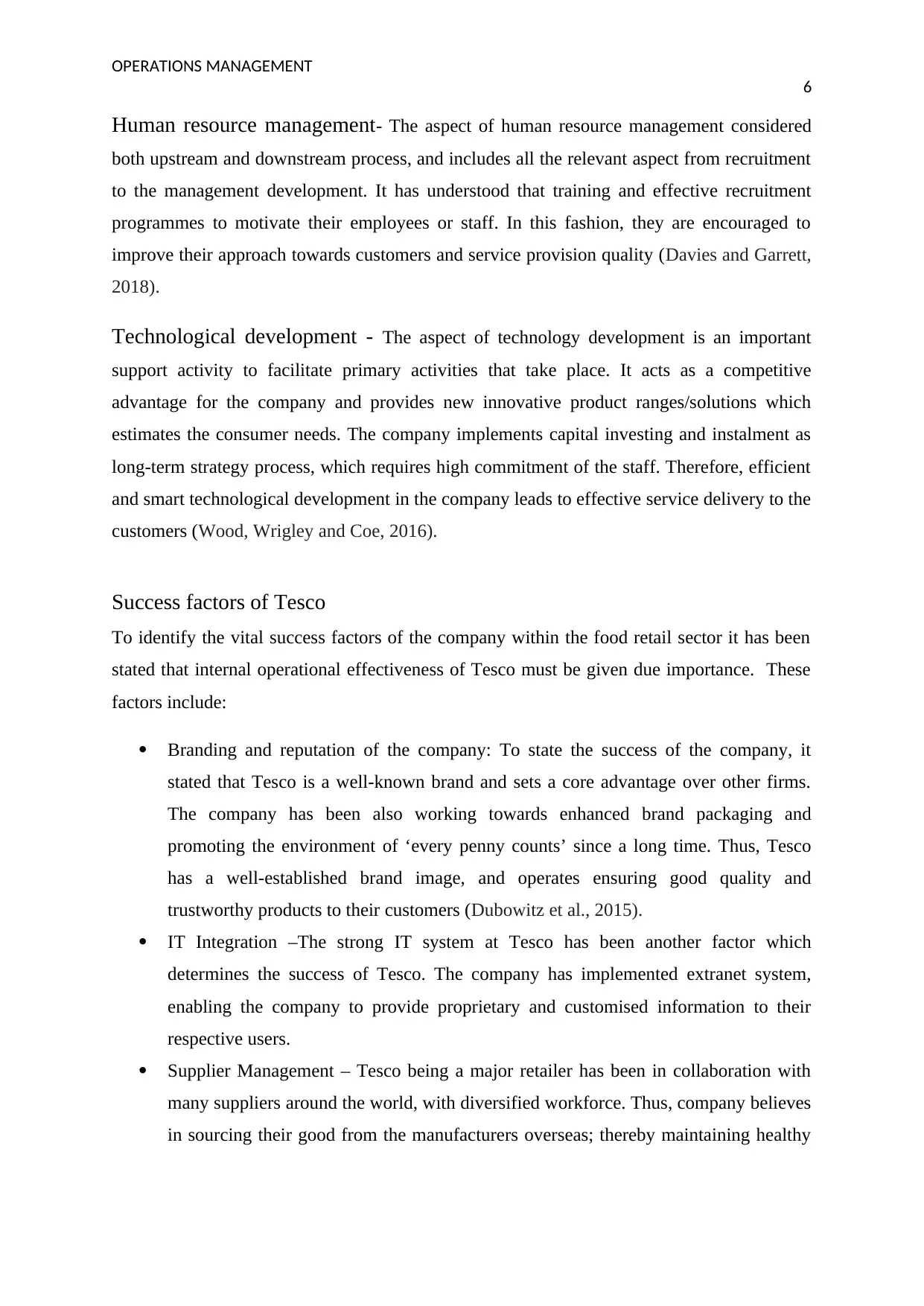
OPERATIONS MANAGEMENT
6
Human resource management- The aspect of human resource management considered
both upstream and downstream process, and includes all the relevant aspect from recruitment
to the management development. It has understood that training and effective recruitment
programmes to motivate their employees or staff. In this fashion, they are encouraged to
improve their approach towards customers and service provision quality (Davies and Garrett,
2018).
Technological development - The aspect of technology development is an important
support activity to facilitate primary activities that take place. It acts as a competitive
advantage for the company and provides new innovative product ranges/solutions which
estimates the consumer needs. The company implements capital investing and instalment as
long-term strategy process, which requires high commitment of the staff. Therefore, efficient
and smart technological development in the company leads to effective service delivery to the
customers (Wood, Wrigley and Coe, 2016).
Success factors of Tesco
To identify the vital success factors of the company within the food retail sector it has been
stated that internal operational effectiveness of Tesco must be given due importance. These
factors include:
Branding and reputation of the company: To state the success of the company, it
stated that Tesco is a well-known brand and sets a core advantage over other firms.
The company has been also working towards enhanced brand packaging and
promoting the environment of ‘every penny counts’ since a long time. Thus, Tesco
has a well-established brand image, and operates ensuring good quality and
trustworthy products to their customers (Dubowitz et al., 2015).
IT Integration –The strong IT system at Tesco has been another factor which
determines the success of Tesco. The company has implemented extranet system,
enabling the company to provide proprietary and customised information to their
respective users.
Supplier Management – Tesco being a major retailer has been in collaboration with
many suppliers around the world, with diversified workforce. Thus, company believes
in sourcing their good from the manufacturers overseas; thereby maintaining healthy
6
Human resource management- The aspect of human resource management considered
both upstream and downstream process, and includes all the relevant aspect from recruitment
to the management development. It has understood that training and effective recruitment
programmes to motivate their employees or staff. In this fashion, they are encouraged to
improve their approach towards customers and service provision quality (Davies and Garrett,
2018).
Technological development - The aspect of technology development is an important
support activity to facilitate primary activities that take place. It acts as a competitive
advantage for the company and provides new innovative product ranges/solutions which
estimates the consumer needs. The company implements capital investing and instalment as
long-term strategy process, which requires high commitment of the staff. Therefore, efficient
and smart technological development in the company leads to effective service delivery to the
customers (Wood, Wrigley and Coe, 2016).
Success factors of Tesco
To identify the vital success factors of the company within the food retail sector it has been
stated that internal operational effectiveness of Tesco must be given due importance. These
factors include:
Branding and reputation of the company: To state the success of the company, it
stated that Tesco is a well-known brand and sets a core advantage over other firms.
The company has been also working towards enhanced brand packaging and
promoting the environment of ‘every penny counts’ since a long time. Thus, Tesco
has a well-established brand image, and operates ensuring good quality and
trustworthy products to their customers (Dubowitz et al., 2015).
IT Integration –The strong IT system at Tesco has been another factor which
determines the success of Tesco. The company has implemented extranet system,
enabling the company to provide proprietary and customised information to their
respective users.
Supplier Management – Tesco being a major retailer has been in collaboration with
many suppliers around the world, with diversified workforce. Thus, company believes
in sourcing their good from the manufacturers overseas; thereby maintaining healthy
Paraphrase This Document
Need a fresh take? Get an instant paraphrase of this document with our AI Paraphraser
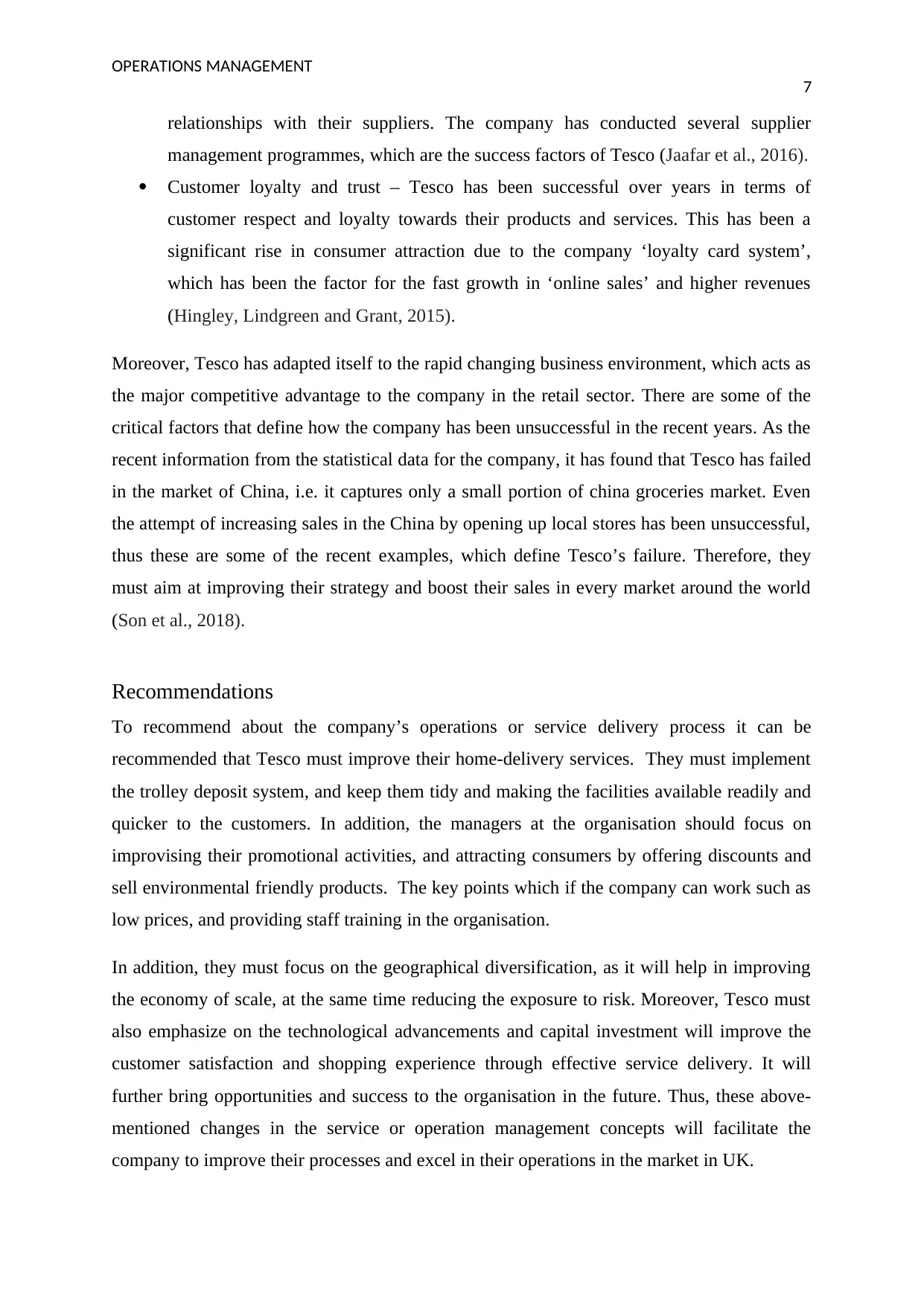
OPERATIONS MANAGEMENT
7
relationships with their suppliers. The company has conducted several supplier
management programmes, which are the success factors of Tesco (Jaafar et al., 2016).
Customer loyalty and trust – Tesco has been successful over years in terms of
customer respect and loyalty towards their products and services. This has been a
significant rise in consumer attraction due to the company ‘loyalty card system’,
which has been the factor for the fast growth in ‘online sales’ and higher revenues
(Hingley, Lindgreen and Grant, 2015).
Moreover, Tesco has adapted itself to the rapid changing business environment, which acts as
the major competitive advantage to the company in the retail sector. There are some of the
critical factors that define how the company has been unsuccessful in the recent years. As the
recent information from the statistical data for the company, it has found that Tesco has failed
in the market of China, i.e. it captures only a small portion of china groceries market. Even
the attempt of increasing sales in the China by opening up local stores has been unsuccessful,
thus these are some of the recent examples, which define Tesco’s failure. Therefore, they
must aim at improving their strategy and boost their sales in every market around the world
(Son et al., 2018).
Recommendations
To recommend about the company’s operations or service delivery process it can be
recommended that Tesco must improve their home-delivery services. They must implement
the trolley deposit system, and keep them tidy and making the facilities available readily and
quicker to the customers. In addition, the managers at the organisation should focus on
improvising their promotional activities, and attracting consumers by offering discounts and
sell environmental friendly products. The key points which if the company can work such as
low prices, and providing staff training in the organisation.
In addition, they must focus on the geographical diversification, as it will help in improving
the economy of scale, at the same time reducing the exposure to risk. Moreover, Tesco must
also emphasize on the technological advancements and capital investment will improve the
customer satisfaction and shopping experience through effective service delivery. It will
further bring opportunities and success to the organisation in the future. Thus, these above-
mentioned changes in the service or operation management concepts will facilitate the
company to improve their processes and excel in their operations in the market in UK.
7
relationships with their suppliers. The company has conducted several supplier
management programmes, which are the success factors of Tesco (Jaafar et al., 2016).
Customer loyalty and trust – Tesco has been successful over years in terms of
customer respect and loyalty towards their products and services. This has been a
significant rise in consumer attraction due to the company ‘loyalty card system’,
which has been the factor for the fast growth in ‘online sales’ and higher revenues
(Hingley, Lindgreen and Grant, 2015).
Moreover, Tesco has adapted itself to the rapid changing business environment, which acts as
the major competitive advantage to the company in the retail sector. There are some of the
critical factors that define how the company has been unsuccessful in the recent years. As the
recent information from the statistical data for the company, it has found that Tesco has failed
in the market of China, i.e. it captures only a small portion of china groceries market. Even
the attempt of increasing sales in the China by opening up local stores has been unsuccessful,
thus these are some of the recent examples, which define Tesco’s failure. Therefore, they
must aim at improving their strategy and boost their sales in every market around the world
(Son et al., 2018).
Recommendations
To recommend about the company’s operations or service delivery process it can be
recommended that Tesco must improve their home-delivery services. They must implement
the trolley deposit system, and keep them tidy and making the facilities available readily and
quicker to the customers. In addition, the managers at the organisation should focus on
improvising their promotional activities, and attracting consumers by offering discounts and
sell environmental friendly products. The key points which if the company can work such as
low prices, and providing staff training in the organisation.
In addition, they must focus on the geographical diversification, as it will help in improving
the economy of scale, at the same time reducing the exposure to risk. Moreover, Tesco must
also emphasize on the technological advancements and capital investment will improve the
customer satisfaction and shopping experience through effective service delivery. It will
further bring opportunities and success to the organisation in the future. Thus, these above-
mentioned changes in the service or operation management concepts will facilitate the
company to improve their processes and excel in their operations in the market in UK.
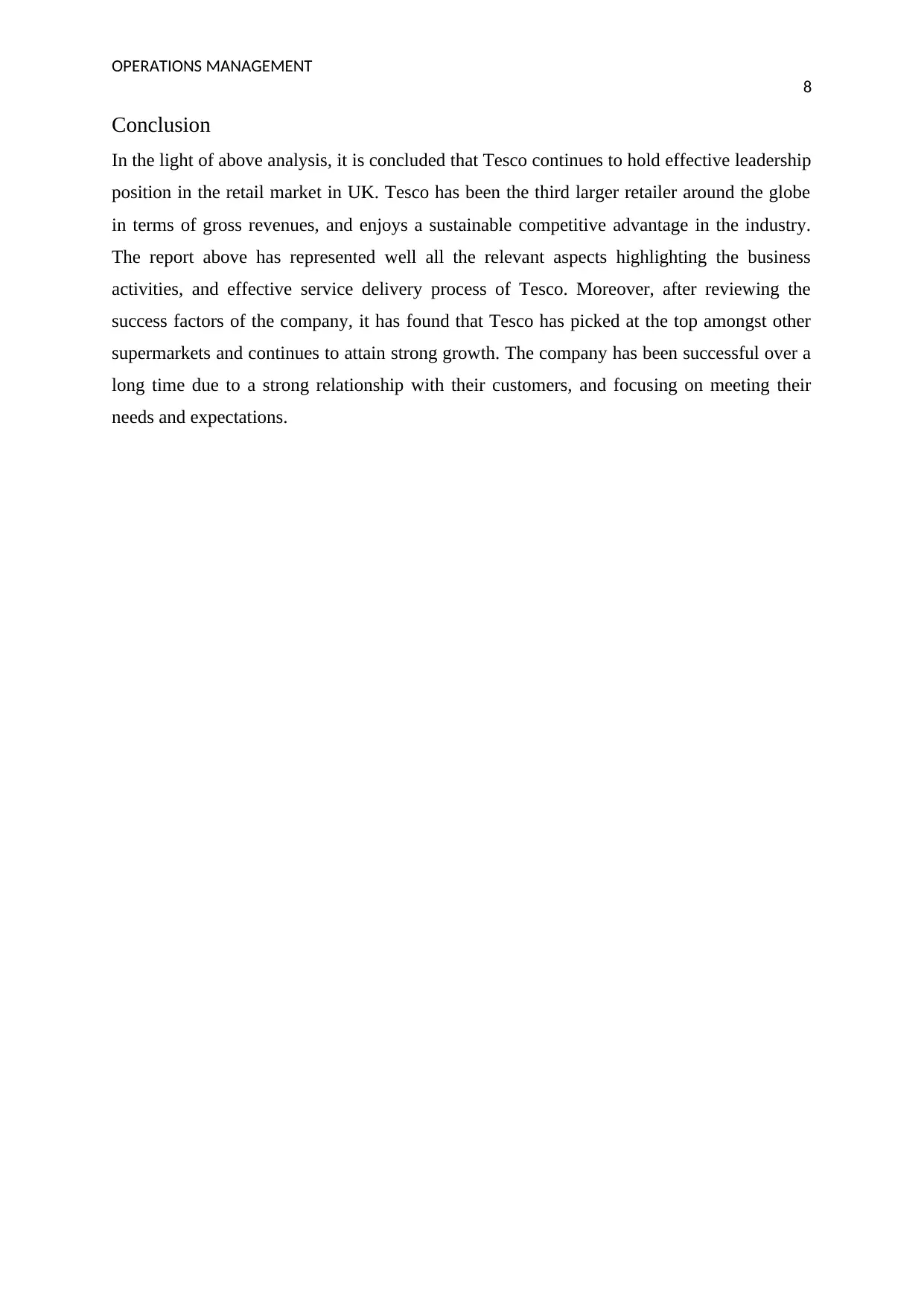
OPERATIONS MANAGEMENT
8
Conclusion
In the light of above analysis, it is concluded that Tesco continues to hold effective leadership
position in the retail market in UK. Tesco has been the third larger retailer around the globe
in terms of gross revenues, and enjoys a sustainable competitive advantage in the industry.
The report above has represented well all the relevant aspects highlighting the business
activities, and effective service delivery process of Tesco. Moreover, after reviewing the
success factors of the company, it has found that Tesco has picked at the top amongst other
supermarkets and continues to attain strong growth. The company has been successful over a
long time due to a strong relationship with their customers, and focusing on meeting their
needs and expectations.
8
Conclusion
In the light of above analysis, it is concluded that Tesco continues to hold effective leadership
position in the retail market in UK. Tesco has been the third larger retailer around the globe
in terms of gross revenues, and enjoys a sustainable competitive advantage in the industry.
The report above has represented well all the relevant aspects highlighting the business
activities, and effective service delivery process of Tesco. Moreover, after reviewing the
success factors of the company, it has found that Tesco has picked at the top amongst other
supermarkets and continues to attain strong growth. The company has been successful over a
long time due to a strong relationship with their customers, and focusing on meeting their
needs and expectations.
⊘ This is a preview!⊘
Do you want full access?
Subscribe today to unlock all pages.

Trusted by 1+ million students worldwide
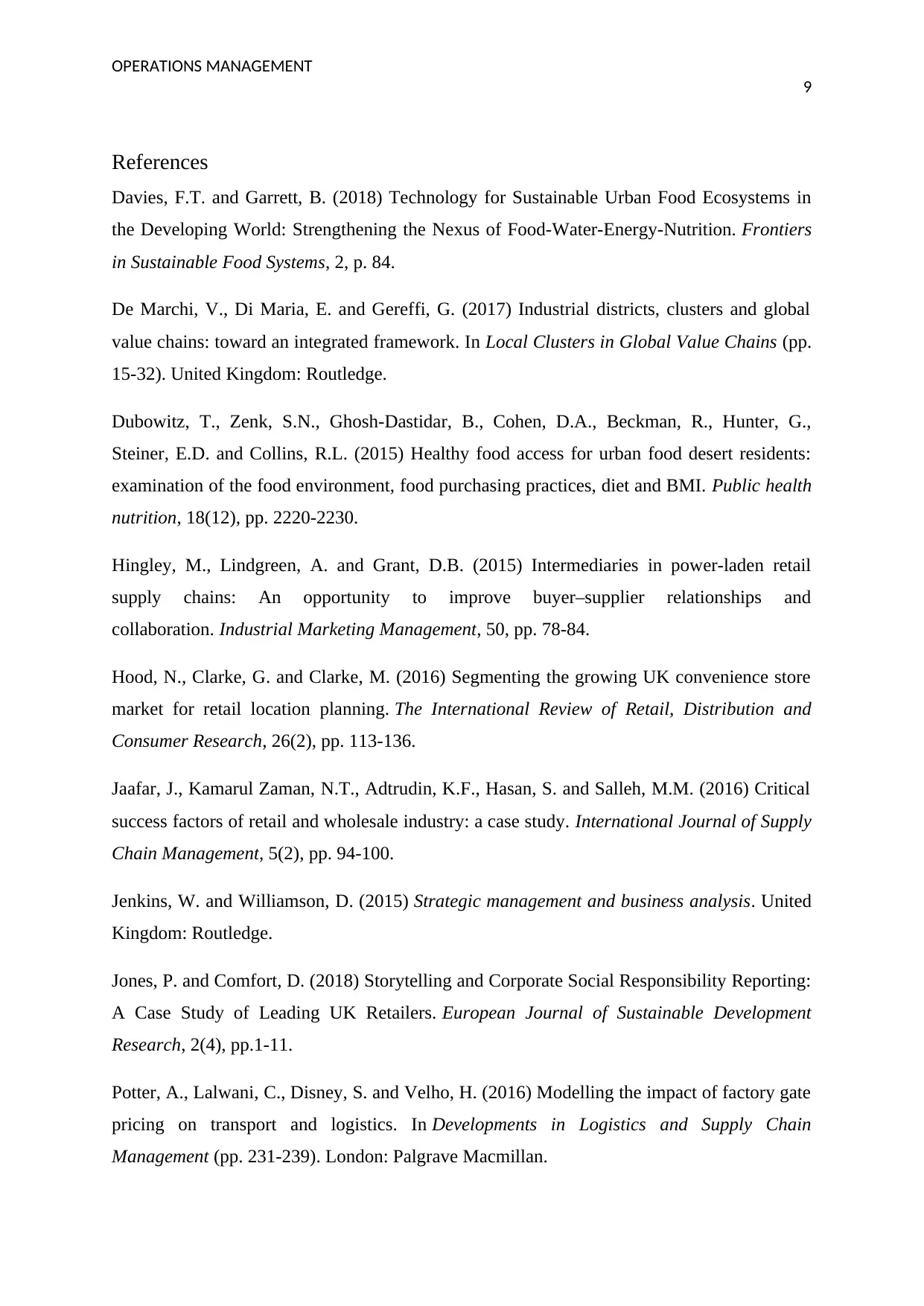
OPERATIONS MANAGEMENT
9
References
Davies, F.T. and Garrett, B. (2018) Technology for Sustainable Urban Food Ecosystems in
the Developing World: Strengthening the Nexus of Food-Water-Energy-Nutrition. Frontiers
in Sustainable Food Systems, 2, p. 84.
De Marchi, V., Di Maria, E. and Gereffi, G. (2017) Industrial districts, clusters and global
value chains: toward an integrated framework. In Local Clusters in Global Value Chains (pp.
15-32). United Kingdom: Routledge.
Dubowitz, T., Zenk, S.N., Ghosh-Dastidar, B., Cohen, D.A., Beckman, R., Hunter, G.,
Steiner, E.D. and Collins, R.L. (2015) Healthy food access for urban food desert residents:
examination of the food environment, food purchasing practices, diet and BMI. Public health
nutrition, 18(12), pp. 2220-2230.
Hingley, M., Lindgreen, A. and Grant, D.B. (2015) Intermediaries in power-laden retail
supply chains: An opportunity to improve buyer–supplier relationships and
collaboration. Industrial Marketing Management, 50, pp. 78-84.
Hood, N., Clarke, G. and Clarke, M. (2016) Segmenting the growing UK convenience store
market for retail location planning. The International Review of Retail, Distribution and
Consumer Research, 26(2), pp. 113-136.
Jaafar, J., Kamarul Zaman, N.T., Adtrudin, K.F., Hasan, S. and Salleh, M.M. (2016) Critical
success factors of retail and wholesale industry: a case study. International Journal of Supply
Chain Management, 5(2), pp. 94-100.
Jenkins, W. and Williamson, D. (2015) Strategic management and business analysis. United
Kingdom: Routledge.
Jones, P. and Comfort, D. (2018) Storytelling and Corporate Social Responsibility Reporting:
A Case Study of Leading UK Retailers. European Journal of Sustainable Development
Research, 2(4), pp.1-11.
Potter, A., Lalwani, C., Disney, S. and Velho, H. (2016) Modelling the impact of factory gate
pricing on transport and logistics. In Developments in Logistics and Supply Chain
Management (pp. 231-239). London: Palgrave Macmillan.
9
References
Davies, F.T. and Garrett, B. (2018) Technology for Sustainable Urban Food Ecosystems in
the Developing World: Strengthening the Nexus of Food-Water-Energy-Nutrition. Frontiers
in Sustainable Food Systems, 2, p. 84.
De Marchi, V., Di Maria, E. and Gereffi, G. (2017) Industrial districts, clusters and global
value chains: toward an integrated framework. In Local Clusters in Global Value Chains (pp.
15-32). United Kingdom: Routledge.
Dubowitz, T., Zenk, S.N., Ghosh-Dastidar, B., Cohen, D.A., Beckman, R., Hunter, G.,
Steiner, E.D. and Collins, R.L. (2015) Healthy food access for urban food desert residents:
examination of the food environment, food purchasing practices, diet and BMI. Public health
nutrition, 18(12), pp. 2220-2230.
Hingley, M., Lindgreen, A. and Grant, D.B. (2015) Intermediaries in power-laden retail
supply chains: An opportunity to improve buyer–supplier relationships and
collaboration. Industrial Marketing Management, 50, pp. 78-84.
Hood, N., Clarke, G. and Clarke, M. (2016) Segmenting the growing UK convenience store
market for retail location planning. The International Review of Retail, Distribution and
Consumer Research, 26(2), pp. 113-136.
Jaafar, J., Kamarul Zaman, N.T., Adtrudin, K.F., Hasan, S. and Salleh, M.M. (2016) Critical
success factors of retail and wholesale industry: a case study. International Journal of Supply
Chain Management, 5(2), pp. 94-100.
Jenkins, W. and Williamson, D. (2015) Strategic management and business analysis. United
Kingdom: Routledge.
Jones, P. and Comfort, D. (2018) Storytelling and Corporate Social Responsibility Reporting:
A Case Study of Leading UK Retailers. European Journal of Sustainable Development
Research, 2(4), pp.1-11.
Potter, A., Lalwani, C., Disney, S. and Velho, H. (2016) Modelling the impact of factory gate
pricing on transport and logistics. In Developments in Logistics and Supply Chain
Management (pp. 231-239). London: Palgrave Macmillan.
Paraphrase This Document
Need a fresh take? Get an instant paraphrase of this document with our AI Paraphraser
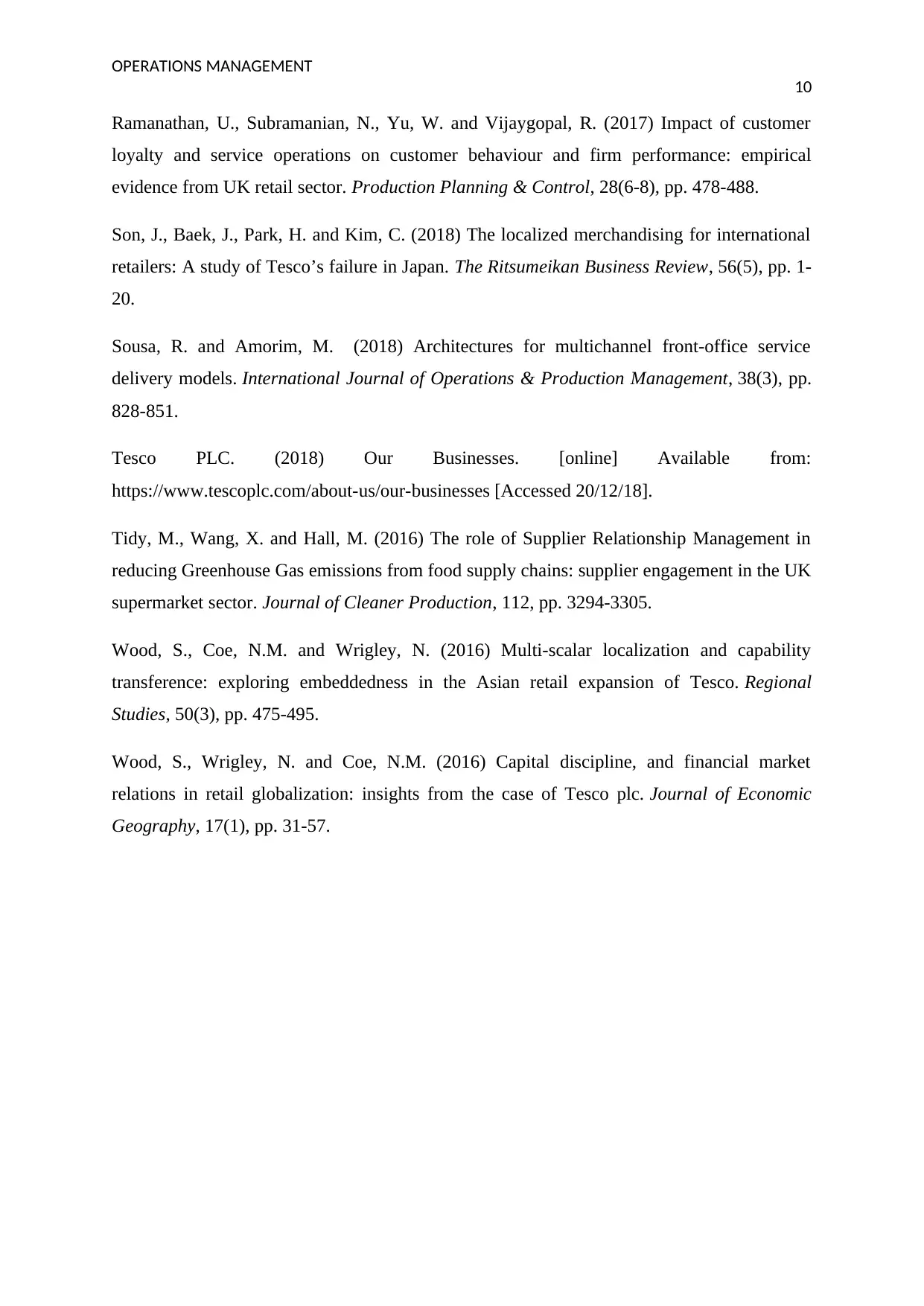
OPERATIONS MANAGEMENT
10
Ramanathan, U., Subramanian, N., Yu, W. and Vijaygopal, R. (2017) Impact of customer
loyalty and service operations on customer behaviour and firm performance: empirical
evidence from UK retail sector. Production Planning & Control, 28(6-8), pp. 478-488.
Son, J., Baek, J., Park, H. and Kim, C. (2018) The localized merchandising for international
retailers: A study of Tesco’s failure in Japan. The Ritsumeikan Business Review, 56(5), pp. 1-
20.
Sousa, R. and Amorim, M. (2018) Architectures for multichannel front-office service
delivery models. International Journal of Operations & Production Management, 38(3), pp.
828-851.
Tesco PLC. (2018) Our Businesses. [online] Available from:
https://www.tescoplc.com/about-us/our-businesses [Accessed 20/12/18].
Tidy, M., Wang, X. and Hall, M. (2016) The role of Supplier Relationship Management in
reducing Greenhouse Gas emissions from food supply chains: supplier engagement in the UK
supermarket sector. Journal of Cleaner Production, 112, pp. 3294-3305.
Wood, S., Coe, N.M. and Wrigley, N. (2016) Multi-scalar localization and capability
transference: exploring embeddedness in the Asian retail expansion of Tesco. Regional
Studies, 50(3), pp. 475-495.
Wood, S., Wrigley, N. and Coe, N.M. (2016) Capital discipline, and financial market
relations in retail globalization: insights from the case of Tesco plc. Journal of Economic
Geography, 17(1), pp. 31-57.
10
Ramanathan, U., Subramanian, N., Yu, W. and Vijaygopal, R. (2017) Impact of customer
loyalty and service operations on customer behaviour and firm performance: empirical
evidence from UK retail sector. Production Planning & Control, 28(6-8), pp. 478-488.
Son, J., Baek, J., Park, H. and Kim, C. (2018) The localized merchandising for international
retailers: A study of Tesco’s failure in Japan. The Ritsumeikan Business Review, 56(5), pp. 1-
20.
Sousa, R. and Amorim, M. (2018) Architectures for multichannel front-office service
delivery models. International Journal of Operations & Production Management, 38(3), pp.
828-851.
Tesco PLC. (2018) Our Businesses. [online] Available from:
https://www.tescoplc.com/about-us/our-businesses [Accessed 20/12/18].
Tidy, M., Wang, X. and Hall, M. (2016) The role of Supplier Relationship Management in
reducing Greenhouse Gas emissions from food supply chains: supplier engagement in the UK
supermarket sector. Journal of Cleaner Production, 112, pp. 3294-3305.
Wood, S., Coe, N.M. and Wrigley, N. (2016) Multi-scalar localization and capability
transference: exploring embeddedness in the Asian retail expansion of Tesco. Regional
Studies, 50(3), pp. 475-495.
Wood, S., Wrigley, N. and Coe, N.M. (2016) Capital discipline, and financial market
relations in retail globalization: insights from the case of Tesco plc. Journal of Economic
Geography, 17(1), pp. 31-57.
1 out of 11
Related Documents
Your All-in-One AI-Powered Toolkit for Academic Success.
+13062052269
info@desklib.com
Available 24*7 on WhatsApp / Email
![[object Object]](/_next/static/media/star-bottom.7253800d.svg)
Unlock your academic potential
© 2024 | Zucol Services PVT LTD | All rights reserved.





